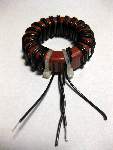 |
The 4:1 Un-Un Craig LaBarge, WB3GCK |
 |
The 4:1 Un-Un Craig LaBarge, WB3GCK |
|
I first did some experimenting with the "un-un" when I built a new vertical antenna to use with my pop-up camper. I was so impressed with the performance of that antenna that I built a second un-un for general-purpose portable operations. Before I get too far into this, let me be clear -- I didn't invent this thing. I merely built one based on information from others and adapted it for my own purposes. Check the references below for a couple of sites that inspired my version. So, what is it? As you probably know, a balun is a transformer that is designed to go between a balance load (like a dipole fed with balance line) and an unbalanced source (like the coax from your rig). Hence the name balun. Well, the un-un is very similar except that it is designed to work with unabalance load, something like a random wire up in a tree with a counterpose wire laying on the ground or a vertical with ground radials. Hence, the name "un-un." This particular un-un is a 4:1 transformer, which seems to work very well in a variety of antenna configurations. When used with an auto-tuner, the un-un turns a simple piece of wire and a counterpoise wire or radials into a multi-band antenna. The popular 43-foot vertical antenna configuration typically uses a 4:1 un-un at the feedpoint. Several vendors offer these commercially.Here are the parts I used:
It's very easy to build. This one took about 2 hours to put together. IW7EHC's web page shows how to wind the toroid and make all of the internal connections, so I won't try to duplicate that here. You can build it with a smaller toroid and lighter guage wire, but I went with the larger toroid and heavier wire to minimize losses. Here are a couple of examples of how I have used it so far:
73, Craig WB3GCK ----- References:
|
 Un-Un Winding on T200-2 core  Inside the Un-Un  Completed Un-Un |